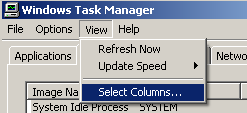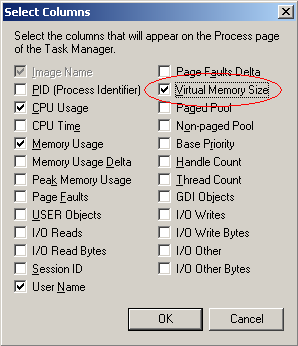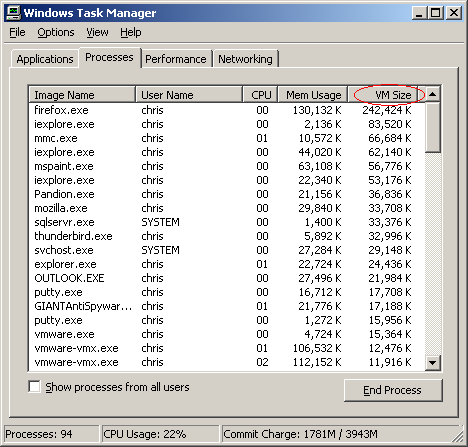Fix "too little virtual memory" in Windows
20:18 Edit This 0 Comments »Finding the source of the problem
First you need to determine which application is causing the problem.
Hit Control-Alt-Delete to bring up Task Manager (on certain XP Professional configurations you'll need to click the Task Manager button after hitting Control-Alt-Delete). You can also access Task Manager by holding down Control and Shift and pressing Escape.
Go to the Processes tab in Task Manager. Here you will see a list of all the processes (applications or parts thereof) that are running on your system. You will see the memory usage here, but in my experience this very rarely has anything to do with problems running low on virtual memory.
Click View, Select Columns.

Check the Virtual Memory Size box, as circled in the screen shot below and click OK.

Now you have a VM Size column in your Processes tab. Click the top of the VM Size column (as circled below) twice to arrange the processes by their VM Size from largest to smallest.

You'll see in this Task Manager shot that Mozilla Firefox is taking up the most virtual memory at about 237 MB, with Internet Explorer the next biggest at about 81 MB. (the number of KB divided by 1024 equals MB) For both, this is the consequence of leaving them open for more than a week straight. Almost every application will use more memory the longer you keep it open, though some are worse than others. This is one reason that Windows becomes more and more unresponsive the longer you keep it running, and why you end up eeding to restart your computer periodically.
Once you determine which process is using more virtual memory than it should, you need to determine what the process is. Some are pretty obvious, like winword.exe is Microsoft Word, iexplore.exe is Internet Explorer, and so on. Others aren't so obvious. The best way to determine the source of a specific process is to use a search engine to search for the Image Name as shown in Task Manager.
Resolution
Now that you know which application is causing the problem, let's resolve it.
One common thing to try is to uninstall and reinstall the offending application if possible. Searching the Internet, and checking the support site of the software vendor would be the next two steps I would try. Without knowing which application is at fault, it's difficult to recommend a specific solution.

0 comments:
Post a Comment